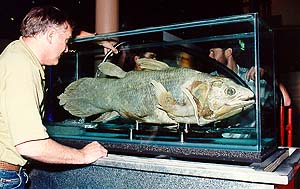
Order: Crossopterygii (formerly Actinistia)
Family: Latimeriidae (formerly Coelacanthidae)
Genus and Species: Latimeria chalumnae
APPEARANCE
The Comoros coelacanth (pronounced see-la-kanth) is a large lobe-finned fish that
was first discovered in 1938. They are easily recognizable with their fleshy
flipper-like fins and three-lobed tail. They can grow up to 2 m (6 ft) in length
and can weigh up to 95 kg (200 lb). The body is covered with blue
bony plates that are each themselves covered with dermal denticles (small
tooth- like points on the skin). The bony plates also contain silvery streaks.
The body and shape of the fish resembles that of fossilized fish and indeed
was only known by fossils until its discovery. The spines of the fins are
hollow and emit a large amount oil and slime. The shape of the fins allow
them to swim in every direction, including upside-down and backwards.
Internally, they are very unusual. The backbone is made up of a
cartilaginous rod called a notochord that is only found in most vertebrates
before birth. The heart is very simple and the kidneys lie on the floor of the
abdomen instead of under the backbone. The kidneys were a great surprise
to scientists because they were joined together instead of in a pair. This
feature is unique and is found in no other animals. The stomach is just a
large bag and the intestine has a spiral valve, a feature found in sharks. The
swimbladder is sheathed in bony scales and is filled with fat. The skull is
hinged and the skull cavity is huge. However, the brain itself is small, is
embodied in fat and lies on two blood ducts.
Comoros coelacanths are thought to be long-lived.
HABITAT
The Comoros coelacanth is a benthic fish and not of the true deep waters. They live
200 m (650 ft) below the sea level. The first specimen was caught off South
Africa and is the only one to be found in that area. All the rest have been
found in the waters surrounding the Comoro Islands near Madagascar. They do not migrate.
Fossilized coelacanths have been found on every continent but Antarctica.
FOOD
The Comoros coelacanth feeds on small benthic fish, such as cardinalfish and
lanternfish. They also prey upon cuttlefish. It is thought that they creep
along the seabed on their flipper-like fins to stalk their food.
BREEDING
Little is known about their breeding habits. However, it is known that they
produce only about five to twenty-six eggs at a time. The eggs hatch inside the
female and the fry are born alive.
ENEMIES
Comoros Coelacanths are slow reproducers and are therefore very sensitive to over
hunting. They have no known natural predators. The fishermen of
Madagascar fish them regularly and use them as food after being salted and
dried. The scales are used as sandpaper. Coelacanths are captured by
scientists because of their peculiarity and they are also wanted as museum
specimens. They are also sought after for their oil which is thought to have
life-extending capabilities. They are considered to be vulnerable.
THE DISCOVERY
On December 22, 1938, a trawler fishing off the mouth of the Chalumna
River caught a strange, blue fish. It was sent to the East London museum
and then on to JLB Smith, who spent much of the rest of his life studying
the unique find. A second fish was caught on December 20, 1952, near the
Comoro Islands. This specimen had only one dorsal fin and was named
Malania anjouanae. It was later found to be the same species of fish as the
1938 find with a deformity.
Since then many other coelacanths have been captured and studied alive.
The 1938 discovery wasn't the first time this fish had been seen; the
fishermen of Madagascar had hunted it for centuries, giving it the name
"Gombessa".
RELATIVES
The coelacanth relatives all died out with the dinosaurs. In 1999, a population of coelacanths living near Sulawesi, Indonesia, was placed as a separate species, Latimeria menadoensis. Their closest living relative is thought to be the African lungfish.
RESOURCES CITED
1. "Coelacanth" Microsoft Encarta 1998
2. "Coelacanth" Webster's Encyclopedia
3. "Coelacanth" Funk and Wagnall's Wildlife Encyclopedia. B.P.C.
Publishing, 1974
4. "Coelacanth" www.amnh.org/Exhibition/Expedition/
Treasures/Coelacanth/coelacan.html
5. "Discovery" www.dinofish.com/discoa.htm
6. "Expeditions" www.dinofish.com/exped.htm
7."Coelacanth" www.panda.org/resources/publications/
species/underthreat/page8.htm